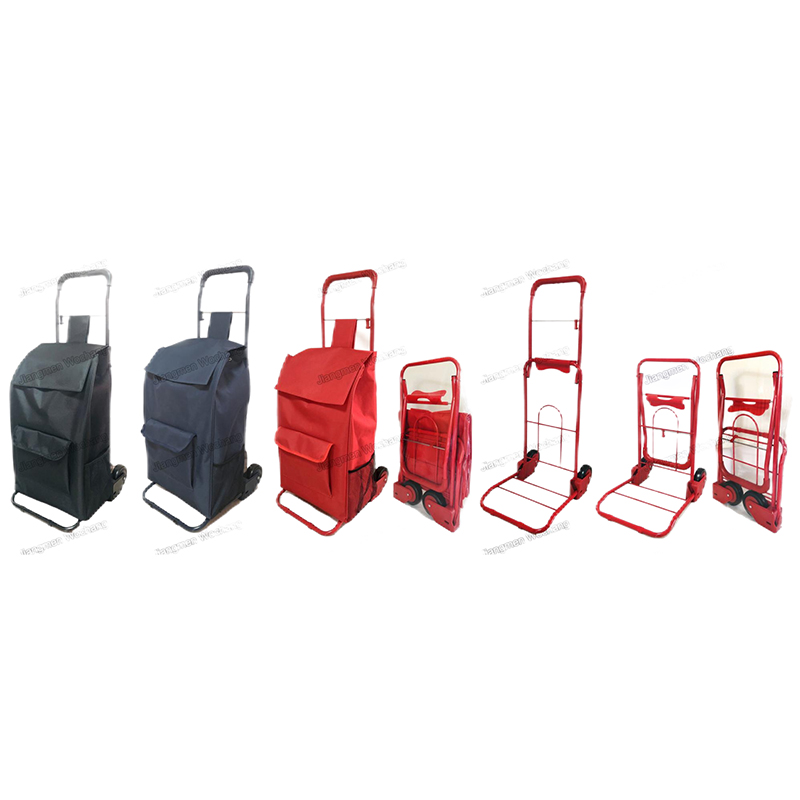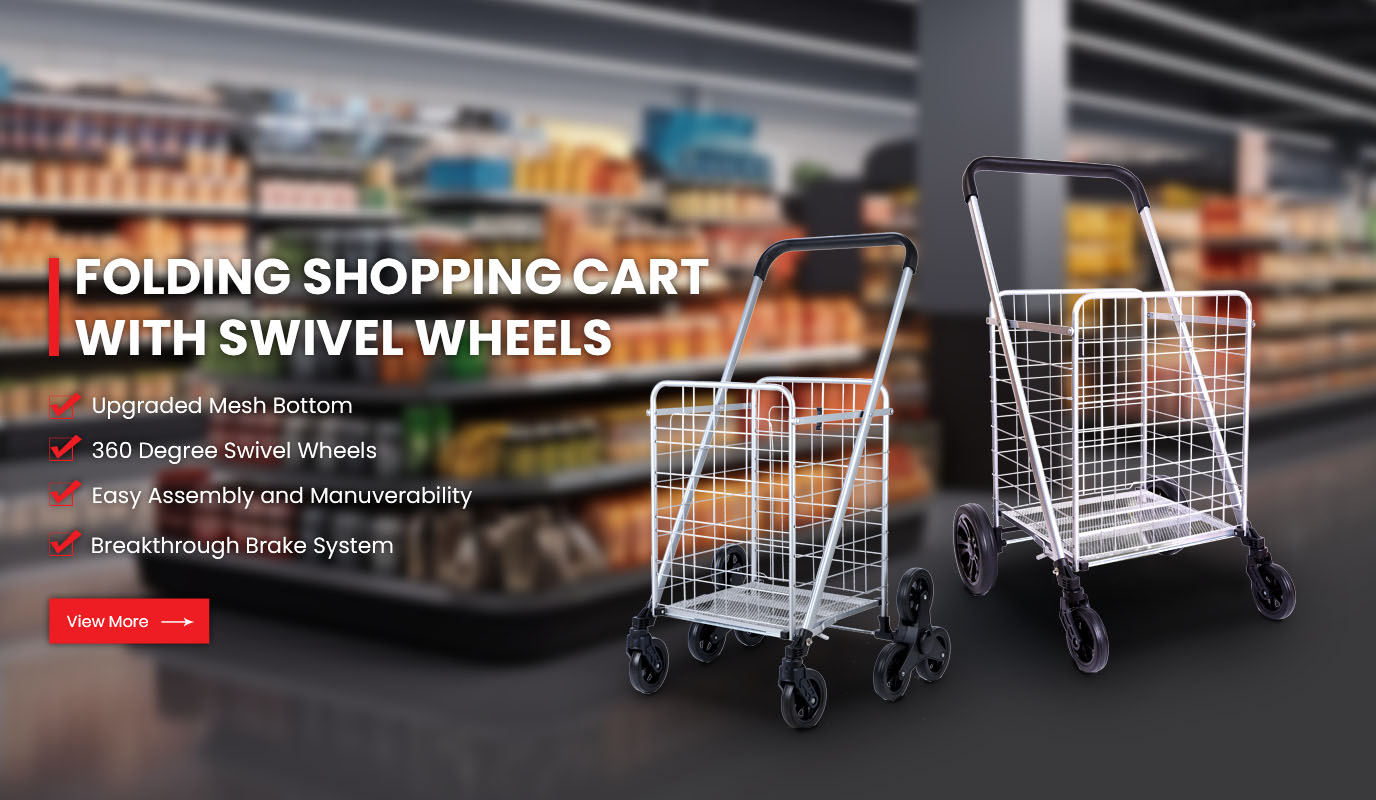Commercialization Path Of Antimicrobial Coated Shopping Carts in Medical And Retail Scenarios
Changes in hygiene needs caused by the epidemic
The global spread of the COVID-19 pandemic has completely changed the public's perception of health and safety. A survey by the World Health Organization shows that 82% of consumers are more concerned about the cleanliness of daily contact items after the epidemic, among which the hygiene standards of medical and retail scenarios have become the focus. Taking hospitals and supermarkets as examples, high-frequency contact rolling Shopping Carts with bags may carry pathogens and become a risk point for cross-infection. This demand shift has spawned a wave of commercialization of antibacterial coating technology - upgrading ordinary tools to "hygiene defense lines" through material innovation.
1. Awakening of health awareness: from passive protection to active choice
Consumers are no longer satisfied with post-disinfection measures such as alcohol spraying, but instead require the product itself to have continuous antibacterial capabilities. According to data from the US CDC, 12% of hospital infection cases are related to surface contamination of medical carts; the bacterial concentration of supermarket shopping cart handles is even higher than that of public toilet door handles. This forces medical and retail institutions to seek solutions with built-in antibacterial functions.
2. Upgrading of hygiene standards: driven by both regulations and the market
The EU's "Medical Equipment Hygiene Standards" implemented in 2023 requires that hospital carts and other equipment must pass ISO 22196 antibacterial tests (antibacterial rate ≥ 99%). Under market pressure, traditional rolling shopping cart with bag manufacturers must transform.

Antibacterial coating technology: from laboratory to commercialization
1. Antibacterial mechanism: blocking the life cycle of microorganisms
Mainstream antibacterial coatings work in three ways:
Contact killing: silver ions, zinc oxide and other ingredients destroy bacterial cell membranes.
Photocatalytic decomposition: Titanium dioxide coatings produce active oxygen under light and degrade organic matter.
Physical barrier: Nano-scale hydrophobic surfaces reduce bacterial attachment, such as lotus leaf-like structures.
Taking the rolling Shopping Cart With Bag used in hospitals as an example, the antibacterial rate of silver ion coatings can reach 99.9%, which is also effective against super bacteria such as MRSA.
2. Material innovation: taking into account both performance and cost
Long-term breakthrough: Microcapsule sustained-release technology allows the antibacterial agent to maintain its activity for more than 5 years, far exceeding the 6-month validity period of traditional coatings.
Environmental protection and safety: The silicone modified coating has passed REACH certification and has no risk of heavy metal precipitation.
Process adaptability: The electrostatic spraying or UV curing process can be used to transform the existing production line, and the cost of adding a single shopping cart is only 3-5 US dollars.
Medical scenario: How antibacterial carts reshape hospital infection control
1. Demand pain points: cross infection and equipment contamination
In hospitals, rolling shopping carts with bags such as drug carts and instrument transport carts come into contact with different wards every day, and the surface may carry drug-resistant bacteria. Statistics from the UK NHS show that daily cleaning can only reduce 60% of pathogen residues, while antibacterial coatings can reduce the risk of contamination by another 85%.
2. Commercialization Case: From ICU to General Ward
After a European hospital introduced antimicrobial coated carts:
ICU infection rate decreased: the incidence of catheter-related bloodstream infection dropped from 2.1 cases/1,000 days to 0.7 cases.
Operation and maintenance cost optimization: cleaning frequency was reduced from 3 times a day to 1 time, saving 120,000 euros in labor costs annually.
Patient trust increased: in the satisfaction survey, the hygiene and safety score increased from 7.2 to 9.1.
3. Certification threshold and market access
Medical-grade antimicrobial coatings must pass ISO 20743 (quantitative antimicrobial testing) and ISO 10993 (biocompatibility testing). Manufacturers need to cooperate with the hospital infection control committee and provide at least 12 months of clinical effect tracking data.
Retail scenario: How antimicrobial shopping carts win consumer trust
1. Consumer behavior change: hygiene becomes a shopping decision factor
Surveys show that 68% of European and American consumers are willing to pay a 10% premium for "antimicrobial certified" products. In supermarkets, the use rate of rolling shopping carts with bags equipped with antibacterial coatings is 40% higher than that of ordinary carts, because the number of bacterial colonies on the handles is as low as 20 CFU/cm².
2. Retail commercialization strategy
Explicit design: Add antibacterial labels to the handles of shopping carts, and display "real-time cleaning effects" with ultraviolet light irradiation.
Data marketing: Push antibacterial test reports of shopping carts through APP, such as "The bacteria on the surface of this cart are reduced by 99%."
Lease value-added: Antibacterial carts are given priority in fresh food areas and maternal and child products areas, and a usage fee of US$0.5 per time is charged.
3. Cost-effectiveness model
Incremental cost: Antibacterial coating increases the cost of a single shopping cart by US$4, but the service life is extended from 5 years to 8 years.
Benefit calculation: Supermarket customer flow increased by 8%, and the cargo damage rate decreased by 15%.
Challenges and future trends
1. Commercialization bottleneck
Inconsistent technical standards: Different countries have different recognition of antibacterial efficacy, which increases the difficulty of global sales.
Consumer cognitive bias: 37% of users mistakenly believe that "antibacterial = no need to clean", resulting in premature wear of the coating.
2. Future innovation direction
Intelligent antibacterial: Equipped with sensors to monitor surface contamination in real time and automatically trigger UV-C disinfection.
Self-healing coating: Mimics the healing mechanism of human skin, and can repair minor scratches autonomously to maintain antibacterial properties.
Cross-border integration: Antibacterial coating combined with the insulation bag of rolling shopping cart with bag



